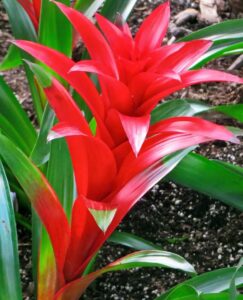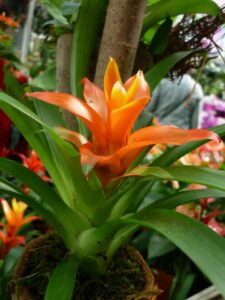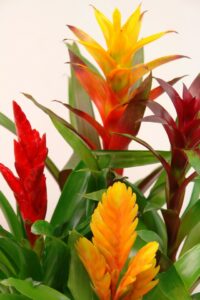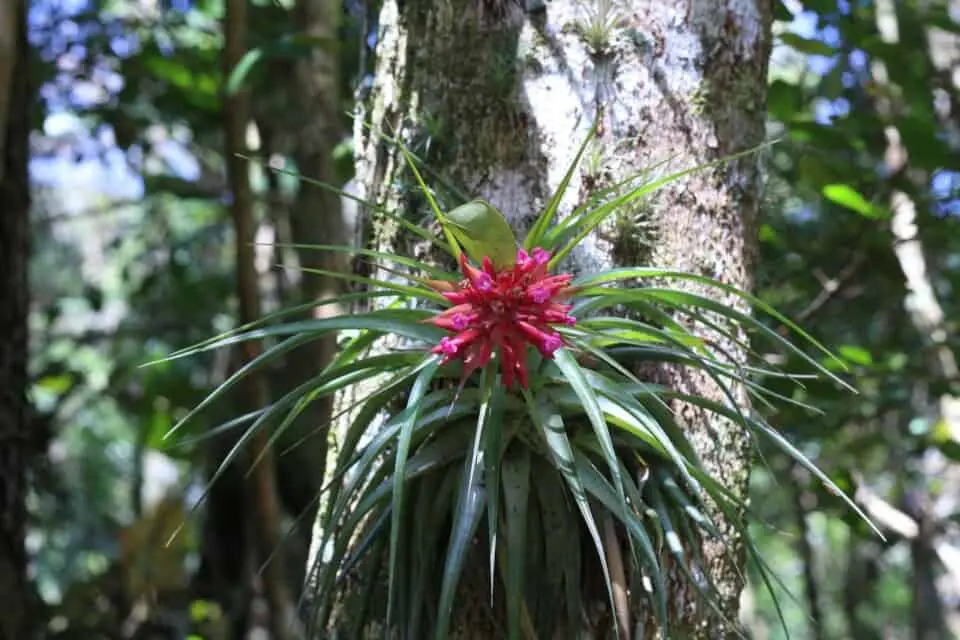Some links in the post are affiliate links and I get a commission from purchases made through some links found in the post.
The enchanting colors found in Bromeliad’s leaves are a sight to be hold. The Bromeliad belongs to the family of Bromeliaceous.
In simple words, it has its place in the pineapple family. Bromeliad has many features and its size is one of them.
It can be difficult to get a Bromeliad to it’s big sizes but if you give it the proper light, water, and temperature to the so, then you will easily get the desired size of plant.
With the large variety of Bromeliad species, the average range is from 1in to 3ft but the largest bromeliad is a Puya Raimondii which can up to 15ft.
How big your bromeliad gets is due to what species you have and how you care for it.
In general, to care for bromeliad, give it indirect bright light, place it at a temperature between 60 to 80 Fahrenheit and give it water once a week. Do not make the plant soggy.
Southern Brazil and Paraguay are the birthplaces of this captivating plant. But now, it is found in all tropical and subtropical areas. There are around 3590 known species present.
The Bromeliad is found in many colors, such as pink, purple, orange, red, and yellow. Bromeliad’s big size also varies from species to species but the care is almost the same for them.
Let’s dig deep into this content to highlight more facts about a Bromeliad and how big can it get.
How Big can Bromeliad Get?
 In general, a Bromeliad grows up to 3 ft in the suitable environment. How big a bromeliad gets depends upon the care and the variety of the plant.
In general, a Bromeliad grows up to 3 ft in the suitable environment. How big a bromeliad gets depends upon the care and the variety of the plant.
A Bromeliad has more than ten varieties and each of them grows to a different size.
For instance, if you have bought Aechmea conifera, an enchanting variety of bromeliad, then it will grow up to 10 ft in height. But some other varieties grow up to 6 ft, such as Dyckia maritima and Hechtia melanocarpa.
But a Billbergia amoena can reach up to 3 ft but this is not the smallest Bromeliad variety.
There are many more Bromeliads which only grow up tp 20 inches. But universally, an indoor Bromeliad size spreads up to 3 ft and has fully colored leaves and an aesthetic appearance.
How Fast does a Bromeliad Grow?
Bromeliad has a relatively slow growth rate, unlike other indoor plants.
If you have bought a baby Bromeliad then it can take 1 – 3 years to mature into a blooming plant. Once it starts thriving, you will observe colorful leaves.
These colorful leaves come in colors such as red, pink, yellow, green, purple, and orange. You will even observe two different colors in the same variety of bromeliad. All you need to expose your plant to the indirect, bright light.
Apart from this, a Bromeliad easily thrives in a home environment. It does not have any special requirement to grow big. Most species of Bromeliad have a 3 to 5 years life span.
The best way to give more life to your plant is to add the correct amount of water and give fertilizer whenever it needs it. Secondly, repot the bromeliad when it needs it.
You may also like: Bromeliad Light Requirements
How to Get a Bromeliad to Grow Bigger?
To have a bromeliad grow bigger, you need to maintain the level of light, soil texture, temperature and humidity, and volume of water.
Apart from this, you also need to know the variety of Bromeliad you are bringing at home.
Because the size you can achieve all depends on the variety/kind/species/genus of bromeliad.
Whether you have bought terrestrial or epiphytic species of Bromeliad, both need a well-draining potting soil mixture.
A well-draining potting mixture will help the Bromeliad to have an upright draining system. A poor potting mixture will disturb the water absorption and can cause the death of the plant.
The terrestrial species of Bromeliad thrives in soil. On the contrary, the epiphytic species of Bromeliad grows attached to other plants, mainly trees.
What species of bromeliad depends on the light it needs, some like bright indirect light. On the contrary, some of the species of Bromeliad like very low levels of light.
In case you are unaware of the species of the Bromeliad, you can set the light level after checking the texture of the plant. If you have a soft texture of leaves and spineless Bromeliad, it will need a low level of light.
While those Bromeliads that have strong spines and have thick leaves need a moderate level of light or indirect bright light. Never expose direct light to a Bromeliad, it will diminish the growth of the Bromeliad.
 The best way to get a Bromeliad to a big size is to create artificial tropical conditions. For instance, a Bromeliad thrives perfectly in a little humidity, a shady place, under or on a tree like in a forest.
The best way to get a Bromeliad to a big size is to create artificial tropical conditions. For instance, a Bromeliad thrives perfectly in a little humidity, a shady place, under or on a tree like in a forest.
It’s better to establish the temperature around 60 to 80 Fahrenheit and set the humidity level around 60%. Bromeliads who are mature and have thick leaves can tolerate up to 20 Fahrenheit degrees in winters.
On the other hand, some species of Bromeliad cannot tolerate lower temperatures. And with immature Bromeliad, you need to be a little more careful. It is favorable to plant them near high temperatures.
To get a Bromeliad to a big size, you need to set the water routine carefully. If you are using the container to grow your Bromeliad, then you need to add water once a week in summer and spring depending on the light and temperature.
The water amount is directly related to these two factors. In winter, add the water when you feel the soil is getting dry check the soil with your finger, up to two inches down in the soil to check the water level.
Bromeliad likes to thrive in a little moist soil but they do not like soggy soil.
On the contrary, if you want a large Bromeliad as in the form of an air plant. Then mist the plant twice a week. Again, do not make the Bromeliad soggy but mist it whenever you observe little dryness over your leaves.
Diluted fertilizer is also significant to getting a big Bromeliad. A Bromeliad does not need fertilizer like other indoor plants. It is enough to add fertilizer once a year.
But do not add fertilizer to your Bromeliad when the winter is approaching.
If you’re enjoying this article, check out our article on the 6 great benefits of having a bromeliad in your home.
What Can You Do If Your Bromeliad Gets Too Big?
Everyone loves their plant thriving and growing big but what to do if your Bromeliad gets too big? Simply, you can go with the repotting option.
First of all, trim all the old and damaged spines of the plant. Similarly, repeat the process with the diseased roots.
Select the right pot or container up to four to six inches in height and you can choose the width of the pot according to the space you have for your plant at your home.
After repotting them, you will have the new look of your Bromeliad and you can re-adjust them as your requirement.
Moreover, if you observe old deadly flowers in your Bromeliad, then it is favorable to cut them. First of all, dead flowers might become toxic for you.
Secondly, it might be consuming the nutrients at a high volume. By cutting them, you will allow the new parts of the plant to take nutrients and grow properly.
Final Thoughts
 A big Bromeliad is not difficult to attain, all you need to do is be a little careful with the plant. Bromeliad thrives in USDA 10-11. Moreover, it likes to grow in acidic soil, about 5.0 to 6.0.
A big Bromeliad is not difficult to attain, all you need to do is be a little careful with the plant. Bromeliad thrives in USDA 10-11. Moreover, it likes to grow in acidic soil, about 5.0 to 6.0.
Bromeliad thrives best in indoor settings. In case you want to thrive in the outdoor settings, then you need to create an artificial environment like they have in the wild for them to grow.
But if you are living in a tropical area, then Bromeliad will be happy already.
Bromeliad has another benefit for you. It doesn’t cage your creativity level. You can grow them in any container/pot or you can grow them as an air plant. You can set them anywhere in your house.
As an indoor plant, Bromeliad also benefits you by keeping your pets safe, a Bromeliad is not toxic to pets, including dogs and cats.
Before you go, here are some more related articles I encourage you to read below to help solve more of your gardening issues:

